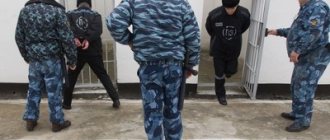Particularly serious crimes: what are they and why are they recognized as such
The Criminal Code of the Russian Federation contains categories of crimes:
- slight heaviness;
- moderate severity;
- heavy;
- especially severe.
More details:
Categories of crimes in the Criminal Code of the Russian Federation by severity Read more
Particularly serious crimes are only intentional crimes, the maximum punishment for which, according to the Criminal Code of the Russian Federation, exceeds 10 years of imprisonment.
We wrote about what an intentional crime is in the article on the elements of the crime in the “Subjective side” section:
The concept and meaning of the crime Read more
Criminal liability
Full criminal liability - tortious capacity
In the language of lawyers, the totality of these parameters is called “tortability”. Article 19 of the Criminal Code of the Russian Federation contains an exhaustive definition of the mentioned concept, as well as a complete list of conditions, the observance of which is necessary to recognize a person guilty of an offense as actually tortious.
If at least one of the points of this officially approved regulation does not correspond to reality, the punishment of the accused for the crime committed will be considered illegal. From the point of view of Russian legislation, it is also considered impossible to bring any legal entity to criminal liability. On the other hand, opening a case against a specific employee of an organization engaged in illegal activities is quite possible.
After all, any employee of such an enterprise involved in criminal fraud is considered to be an individual who is fully aware of the social significance of certain of his actions (but, of course, only if he is recognized as tortious).
Differences between especially serious crimes and other crimes
Particularly serious crimes according to the Criminal Code of the Russian Federation:
- solely intentional
- encroach on the most important and carefully protected goods: life, health, sexual integrity of a person, as well as world security.
The high degree of danger of this category of crimes is emphasized by the fact that liability for them is possible already at the preparation stage (Parts 1, 2 of Article 30 of the Criminal Code of the Russian Federation). However, this does not invalidate Art. 31 of the Criminal Code of the Russian Federation on voluntary refusal, entailing release from liability, which applies to particularly serious crimes in full .
You may also be interested in the article on the ConsultantPlus website “Is it advisable to exclude crimes of a grave category from the special procedure for judicial proceedings provided for by Chapter 40 of the Code of Criminal Procedure of the Russian Federation?” If you do not yet have access to the ConsultantPlus system, you can obtain it free of charge for 2 days.
Signs of crime
The crime is characterized by the following features:
- danger to society;
- illegality under criminal law;
- guilt;
- punishable under the Criminal Code of the Russian Federation.
The material side of a criminal act is characterized by danger to society, that is, causing significant harm to the legitimate interests of a citizen, society or state (coalition of countries). Harm can be physical, moral or property. Any crime is considered such only if there are actions that create danger. This is the main sign of a crime that determines its classification according to severity.
Violation of criminal legislation is a fairly formal sign of a crime, characterizing its legal essence. It means that it is impossible to commit an act without subsequent punishment.
Guilt is a deliberate understanding of the inevitability of criminal liability, which means the commission by a citizen of an illegal act with intent or negligence.
Criminal liability is a mandatory reaction of state law enforcement agencies in relation to a citizen who has committed an offense dangerous to public life.
Is murder a particularly serious crime or not?
Yes, murder is a particularly serious crime, since the maximum penalty for it clearly exceeds 10 years in prison. The maximum for murder without aggravating circumstances is 15 years (Part 1 of Article 105 of the Criminal Code of the Russian Federation):
And for aggravated murder the punishment generally reaches life imprisonment.
But Article 105 of the Criminal Code of the Russian Federation is not the only rule providing for liability for murder!
The Criminal Code has 3 more types of murders, which are not particularly serious. These are the so-called privileged crimes, that is, murders committed under significant mitigating circumstances:
And these “mitigated” murders are not particularly serious; they fall into the categories of moderate or even slight severity.
Types of murders and their severity - table
| Type of murder | Norm of the Criminal Code of the Russian Federation | Maximum penalty | Category (severity) |
| Simple (without mitigating or aggravating circumstances) | Part 1 Art. 105 Criminal Code of the Russian Federation | 15 years imprisonment | Particularly serious |
| Qualified (with aggravating circumstances) | Part 2 Art. 105 Criminal Code of the Russian Federation | 20 years imprisonment or life imprisonment | Particularly serious |
| Murder of a newborn child by a mother | Art. 106 of the Criminal Code of the Russian Federation | 4 years imprisonment | Moderate |
| Murder of one person in a state of passion | Part 1 Art. 107 Criminal Code of the Russian Federation | 3 years imprisonment | Light weight |
| Murder of two or more people in a state of passion | Part 2 Art. 107 Criminal Code of the Russian Federation | 5 years imprisonment | Moderate |
| Killing beyond the limits of necessary defense | Part 1 Art. 108 Criminal Code of the Russian Federation | 2 years imprisonment | Light weight |
| Murder by exceeding the measures necessary to apprehend the criminal | Part 2 Art. 108 Criminal Code of the Russian Federation | 3 years imprisonment | Light weight |
Please note: murder is not the only way to cause death to a person. There are many other articles in the Criminal Code of the Russian Federation that provide for liability for crimes resulting in the death of the victim.
Qualification by object
The Crime Code subdivides based on the object of the attack (what the illegal act was aimed at):
- life (murder);
- human health (beatings, bodily injuries);
- freedom and dignity of the individual (slander);
- sexual integrity of the individual (violent actions);
- citizen's rights (disclosure of personal data, secrets of adoption);
- minor children;
- private property (theft, damage to property, car theft);
- activities and entrepreneurship (tax evasion, falsification of financial statements, espionage).
Particularly serious crimes - examples and list
The Criminal Code of the Russian Federation contains more than 30 articles containing especially serious crimes. Here are the most common ones.
Particularly serious crimes against life
Among the crimes against life, the most serious are:
| Crime | Norm of the Criminal Code of the Russian Federation | Maximum penalty |
| Murder | Art. 105 of the Criminal Code of the Russian Federation | Life imprisonment or death penalty (not imposed since 1999 due to a moratorium) |
| Incitement to suicide committed: · in relation to a minor or a dependent person; · in relation to a pregnant woman; · in relation to 2 or more persons; · in public speaking, including via the Internet; · group of persons | Part 2 Art. 110 of the Criminal Code of the Russian Federation | 15 years imprisonment |
| Inducement to suicide or assistance in it, committed, resulting in suicide or attempted suicide, committed in relation to: · minor; · helpless; · dependent on the perpetrator; · pregnant | Part 5 Art. 110.1 of the Criminal Code of the Russian Federation | 12 years imprisonment |
| Inducement to suicide or assistance in it, committed, resulting in suicide or attempted suicide of 2 or more persons | part 6 art. 110.1 of the Criminal Code of the Russian Federation | 15 years imprisonment |
Particularly serious crimes against health
Among crimes against health, there are only 2 particularly serious crimes:
| Crime | Norm of the Criminal Code of the Russian Federation | Maximum penalty |
| Intentional infliction of grievous bodily harm committed: · a group of persons; against 2 or more persons | Part 3 Art. 111 of the Criminal Code of the Russian Federation | 12 years imprisonment |
| Intentional infliction of grievous bodily harm resulting in the death of the victim | Part 4 Art. 111 of the Criminal Code of the Russian Federation | 15 years imprisonment |
Particularly serious crimes against sexual integrity and sexual freedom
Among the “sexual” crimes, there are many more particularly serious ones. Let's list the most common ones:
| Crime | Norm of the Criminal Code of the Russian Federation | Maximum penalty |
| Rape/other sexual assault: · minor/him from 14 to 18 years old; resulting in HIV infection or serious harm to health | Part 3 Art. 131 of the Criminal Code of the Russian Federation/ Part 3 Art. 132 of the Criminal Code of the Russian Federation | 15 years imprisonment |
| Rape/other sexual assault: · a minor under 14 years of age; · causing death | Part 4 Art. 131 of the Criminal Code of the Russian Federation/ Part 4 Art. 132 of the Criminal Code of the Russian Federation | 20 years imprisonment |
| Rape/other violent acts of a sexual nature against a minor/person under 14 years of age by a person previously convicted of similar crimes | Part 5 Art. 131 of the Criminal Code of the Russian Federation/ Part 5 Art. 132 of the Criminal Code of the Russian Federation | 20 years imprisonment or life imprisonment |
Particularly serious crimes against property
The most common particularly serious crimes against property:
| Crime | Norm of the Criminal Code of the Russian Federation | Maximum penalty |
| Robbery committed: · organized group; · on an especially large scale (amounting to more than 1 million rubles) | Part 3 Art. 161 of the Criminal Code of the Russian Federation | 12 years imprisonment |
| Robbery committed: · with illegal entry into a home or other premises; · on a large scale (amounting to more than RUB 250,000) | Part 3 Art. 162 of the Criminal Code of the Russian Federation | 12 years imprisonment |
| Robbery committed: · organized group; · on a particularly large scale; causing serious harm to health | Part 4 Art. 162 of the Criminal Code of the Russian Federation | 15 years imprisonment |
| Extortion committed: · organized group; · on a large scale; causing serious harm to health | Part 3 Art. 163 of the Criminal Code of the Russian Federation | 15 years imprisonment |
| Theft of a vehicle committed with the use of violence dangerous to life or health or the threat of its use | Part 4 Art. 166 of the Criminal Code of the Russian Federation | 12 years imprisonment |
Why is it necessary to qualify criminal acts?
Assignment to one of four categories entails certain consequences for the convicted person, related to:
- with prosecution (according to criminal law) and release from it;
- with the imposition of punishment and its mitigation.
The consequences of an illegal action belonging to one or another category of severity are:
- clarification of the fact of the presence of a relapse of a criminal act (ordinary or dangerous) in the committed act;
- criminality or non-criminality of preparation for committing a crime;
- determining the procedure and maximum limits for imposing criminal punishment for the sum of several crimes;
- determining the type of institution (colony, prison, settlement) for criminals to serve their sentences in the form of imprisonment;
- definition of release rules;
- determining the size of the terms upon completion of which the convicted person is allowed to use parole from serving the remaining term of the sentence;
- the use of replacing a certain part of the punishment with a more lenient form;
- calculation of the limitation period for the execution of a court sentence, if it is guilty;
- expungement of a criminal record.
Coercive measures
A very important change in criminal legislation was introduced four years ago. A law was passed allowing the use of special measures of medical intervention for violators who have committed unlawful acts that are classified as crimes of minor gravity. Before this innovation, mandatory compulsory treatment measures could not be applied to insane citizens who, for example, interfere with the lives of their neighbors through inappropriate actions. Even if they have committed an offense related to crimes of minor gravity. The courts were forced to dismiss such cases.
Forms of criminal activity
Legal science identifies such forms of criminal activity as:
- Political crime.
It implies all kinds of abuses by the authorities against their own people for political purposes and criminal prosecution for secret political reasons. This also includes abuse of official position and abuse of power.
- Profitable crime. This form contains various crimes affecting market relations (fictitious financial transactions, creation of false companies, etc.). Often, modern achievements of science and technology are used here (for example, theft by infiltrating bank computer networks).
- Violent crime.
This form of criminal activity includes terrorism, premeditated murder, grievous bodily harm and violent selfish actions (for example, robbery, extortion).
- Organized crime.
It is a form of illegal activity that is carried out by entire groups of criminals monopolizing various areas.
- Crime of marginalized groups.
Crimes of this form are committed mainly by people who remain on the edge of reforms in educational, cultural, financial and other spheres of society (refugees and illegal emigrants are also included here).
- Financial crime.
It is formed in the process and due to the interaction of the state and the economy. The public danger of financial crime lies in the negative impact on social structures and in non-compliance with the established order.
- Latent crime.
This form includes crimes that remained unknown to the authorized bodies due to the criminals’ concealment of their own actions or due to the reluctance of victims and witnesses to file statements with the designated bodies.
- Juvenile delinquency.
This form of criminal activity is increasing at a rapid pace and is considered an acute state and social problem. This is due to the fact that factors such as changes in social connections, an unstable financial situation, and the lack of a clear system of national values primarily affect children.
Typical examples of light weight
The Code contains several provisions that prescribe punishment within three years of imprisonment. Among minor crimes there are acts that infringe:
- For life. For example, a murder committed in an inadequate state (loss of memory, self-control).
- Health. Causing minor harm to health.
- Private property. For example, theft of other people's documents. Computer hacking causing property damage.
- Economic activity. For example, illegal restriction of entrepreneurship.
- Human dignity. Defaming another person and accusing him of committing a non-existent crime or defamation in the media, during public speeches and in works of fiction. Illegal disclosure of the secret of adoption.
When determining the punishment for a crime of minor gravity, the judge also proceeds from the assessment of the target of the attack.
Commentary on Article 25 of the Criminal Code of the Russian Federation
1. The concepts of direct and indirect intent were introduced and normatively defined for the first time in the criminal legislation of Russia.
When bringing to justice for committing an intentional crime, based on the principle of subjective imputation, it is necessary to establish that all circumstances of legal significance, i.e. which are signs of a crime (main or qualified), related to the characteristics of the object and subject, the objective and subjective side of the crime, were recognized by the perpetrator. The exception is crimes committed with two forms of guilt (see commentary to Article 27).
A mandatory element of intent is the person’s awareness not only of the factual circumstances of the act he is committing (action or inaction), but also of its social danger, i.e. his ability to cause harm to legally protected objects of criminal law protection. The signs of intentional guilt do not include awareness of the criminal wrongfulness of the act committed. However, the social danger of a number of acts provided for by the Criminal Code as crimes is associated primarily with the fact that a person violates any rule or prohibition, i.e. acts contrary to the law (for example, Articles 127, 128, 139, 223, 256, 258, 260 of the Criminal Code, etc.). Therefore, in such cases, a person’s awareness of the social danger of an action (inaction) includes an understanding of the prohibition of the act he commits.
2. The distinction between direct and indirect types of intent is made both by the intellectual element (the nature of foreseeing socially dangerous consequences) and by the volitional element (attitude towards foreseeable socially dangerous consequences).
A person acting with indirect intent foresees only the real possibility of socially dangerous consequences occurring as a result of his action or inaction, realizing, however, that these consequences may not occur. In the case of committing a crime with direct intent, the perpetrator foresees not only the real possibility of the occurrence of socially dangerous consequences, but also, as emphasized in Part 2 of the commented article, the inevitability of the occurrence of such consequences. Consequently, foreseeing the inevitability of consequences, i.e. an unambiguous causal connection between an act and a consequence (in material elements) is possible only in a crime with direct intent, including attempted crimes.
Indirect intent cannot take place in crimes with a formal composition, the end of which is the fact of the commission of an action (inaction). So, from the contents of Art. 291 of the Criminal Code in conjunction with Art. 5, part 2 art. 24 and Art. 290 of the Criminal Code it follows that the criminal law presupposes the possibility of qualifying an act as giving a bribe only if direct intent and personal interest in the commission of certain actions (inaction) by the bribe recipient is established in the person’s actions <1>.
——————————— <1> See: Determination of the Constitutional Court of the Russian Federation dated October 10, 2002 N 328-O “On the refusal to accept for consideration the complaint of citizen Valery Sergeevich Khaimin about the violation of his constitutional rights by part one of Article 291 of the Criminal Code Code of the Russian Federation".
3. The practical significance of distinguishing between direct and indirect intent is manifested primarily when resolving issues of responsibility for an unfinished crime. Preparing to commit a crime (Part 1 of Article 30 of the Criminal Code) and attempting to commit a crime (Part 3 of Article 30 of the Criminal Code) is possible only with direct intent. So, if murder (Articles 105 - 107 of the Criminal Code) can be committed with both direct and indirect intent, then attempted murder is possible only with direct intent, i.e. when the act indicated that the culprit was aware of the social danger of his actions (inaction), foresaw the possibility or inevitability of the death of another person and wanted it to happen, but the death did not occur due to circumstances beyond his control (see paragraph 2 of the Resolution of the Plenum of the Supreme Court RF dated January 27, 1999 N 1).
If the culprit acted with indirect intent, but a socially dangerous consequence, the possibility of which he foresaw without wanting it to occur, but only consciously allowing it or being indifferent, did not occur, then he is subject to liability only for what was actually done (in particular, under Article 111 of the Criminal Code ), and not for an attempt for a consequence that occurred, but was not desired by him.
For example, in a case of illegal acquisition and carrying of an explosive device - a grenade, as well as attempted murder, the actions of the convicted person were reclassified from Part 3 of Art. 30 and sub. “a”, “e” part 2 art. 105 of the Criminal Code on Part 1 of Art. 118 of the Criminal Code, since the court, on the basis of the examined evidence, has not reliably established the direct intent and motive for the attempted murder of two persons in a generally dangerous manner; the actions of the convicted person were reclassified taking into account the actual serious harm to health caused to A., and minor harm to health to P. - due to negligence.
The Criminal Code does not provide for liability for careless infliction of minor harm to health, and therefore what was done in this part by a convicted person who is not a special subject is qualified under Part 1 of Art. 118 of the Criminal Code as causing grievous harm to A.’s health through negligence in the form of negligence, since F. did not foresee the possibility of the occurrence of the indicated socially dangerous consequences of his actions, although with the necessary care and forethought he should and could have foreseen these consequences, as defined in Art. 26 Criminal Code <1>.
——————————— <1> Determination of the Judicial Collegium for Criminal Cases of the Armed Forces of the Russian Federation dated November 14, 2007 in case No. 47-O07-56.
4. When deciding on the type of intent, one should proceed from the totality of all the circumstances of the crime. In particular, when establishing the content and direction of intent in order to distinguish between crimes against life and crimes against health, it is necessary to pay attention to the method and weapon of the crime, the number, nature and location of bodily injuries (for example, injuries to vital organs of a person), as well as the preceding crime and the subsequent behavior of the perpetrator and the victim, their relationship (see paragraph 3 of the Resolution of the Plenum of the Armed Forces of the Russian Federation dated January 27, 1999 No. 1).
5. For the same purposes, one should take into account other types of intent identified in the theory of criminal law: premeditated and suddenly arising, specified (definite) and unspecified (undefined). Thus, sudden intent is characteristic of crimes committed in a state of passion (Articles 107 and 113 of the Criminal Code).
Of practical importance for the qualification of crimes is the establishment of direct, specified or unspecified intent. In the first case, the guilty person foresees and desires the occurrence of a certain consequence (for example, the death of a person, theft of someone else’s property on a large scale, etc.). If this foreseen and desired consequence did not occur for reasons beyond the control of the person, then, based on the subjective nature of his act, he is liable for attempted crime. And vice versa, a person acting with direct, specific intent, foresees and wants to cause harm, but imagines the consequences only in general terms, variably, wishing for any of them to occur. With such a subjective attitude, the person is responsible for the actual consequence. This provision corresponds to the objective-subjective content of the basis of responsibility, according to which a person is responsible for an act covered by the consciousness of the subject in the form of intent or negligence, and not just for some ideal intent or negligence <1>.
——————————— <1> For more details, see, for example: Tolkachenko A.A. Problems of the subjective side of crime. M., 2005.
6. The consciousness of a person and, consequently, his intent and guilt (as a specific scope of the charge) when committing a certain crime should cover such objective factors as the characteristics of the victim (Articles 105, 131, 277, 295, 317 of the Criminal Code), features of the subject crimes (Articles 158, 164, 193 of the Criminal Code), method of action (Articles 160, 159, 163 of the Criminal Code, etc.), place of action (Articles 158, 161, 162 of the Criminal Code, etc.), instruments of crime (Articles 162, 205, 206, 207 of the Criminal Code, etc.), illegality, knowledge of a person’s actions (Articles 139, 158, 260 of the Criminal Code). In addition, the consciousness of the guilty subject must cover objective and subjective circumstances that mitigate (Article 61 of the Criminal Code) and aggravate (Article 63 of the Criminal Code) the punishment <1>, the repeated consideration of which is also not permissible.
——————————— <1> See: Tkachenko V.I. Crimes with double guilt // Legislation. 1998. N 5.








